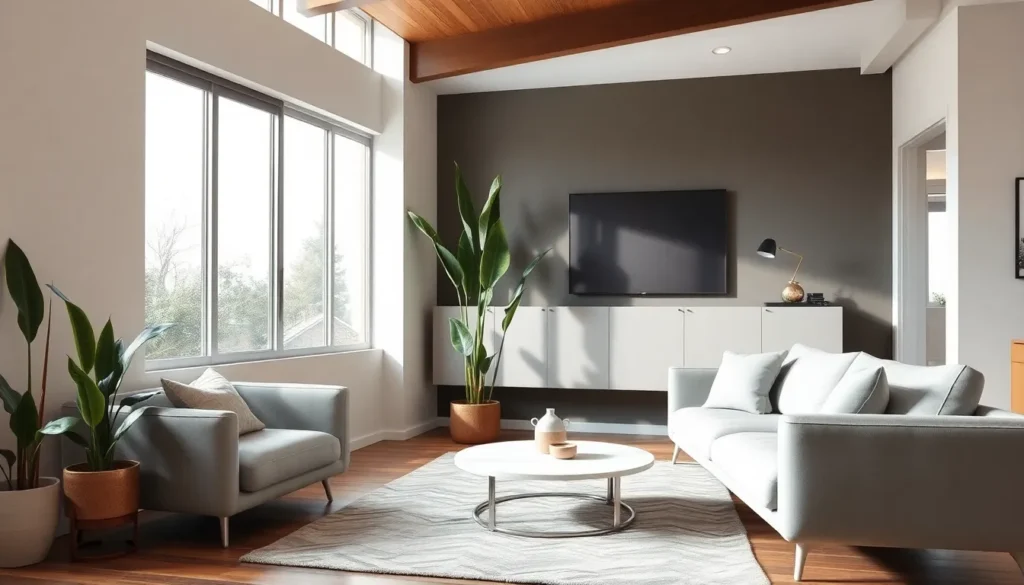We’ve all seen those stunning mid-century modern interiors with their clean lines and timeless appeal – but what really brings these spaces to life are the perfect plants that complement this iconic design aesthetic. Mid-century modern plants aren’t just greenery; they’re architectural elements that enhance the sophisticated simplicity this style is famous for.
The mid-century modern movement embraced bringing nature indoors, and today’s plant enthusiasts are rediscovering which species work best with this design philosophy. From dramatic sculptural forms to plants with bold geometric leaves, the right botanical choices can transform your space into a magazine-worthy mid-century haven.
Whether you’re furnishing a new home or refreshing your current space, understanding which plants harmonize with mid-century modern design will help you create that coveted indoor-outdoor living experience that defined the era. We’ll explore the most striking plant varieties that’ll make your space feel both retro and refreshingly contemporary.
Snake Plants: The Ultimate Mid Century Modern Statement Piece
Snake plants perfectly embody the architectural essence that defined mid century modern design. Their bold, sculptural presence transforms any interior space into a sophisticated showcase of form and function.
Low Maintenance Care Requirements
Snake plants thrive with minimal attention, making them ideal for busy homeowners who want stylish greenery without constant upkeep. We recommend watering them only when the soil completely dries out, typically every 2-3 weeks during growing seasons.
These resilient plants tolerate low light conditions exceptionally well, flourishing in the filtered sunlight that floor-to-ceiling windows often provide in mid century homes. Overwatering poses the biggest threat to snake plants, so we suggest checking soil moisture with your finger before adding water.
Temperature fluctuations don’t faze these hardy specimens, as they adapt comfortably to indoor environments between 60-80°F. Fertilizing becomes necessary only twice yearly during spring and summer months using diluted houseplant fertilizer.
Architectural Vertical Lines
Snake plants create striking vertical elements that complement the clean geometry of mid century modern furniture and decor. Their sword-like leaves shoot upward in dramatic fashion, echoing the vertical lines found in iconic room dividers and floor lamps from the era.
We love positioning snake plants near low-profile sofas and sleek coffee tables where their height creates visual balance and draws the eye upward. The plants’ naturally upright growth pattern mirrors the architectural emphasis on vertical space that mid century designers championed.
Grouping multiple snake plants of varying heights produces a sculptural arrangement that functions like living art installations. Their geometric leaf patterns featuring yellow borders and dark green centers add organic texture while maintaining the period’s preference for bold, simple forms.
Air Purifying Benefits
Snake plants actively remove harmful toxins from indoor air, including formaldehyde, xylene, and toluene commonly found in mid century homes with original materials. NASA studies confirm these plants convert carbon dioxide to oxygen during nighttime hours, unlike most houseplants that only photosynthesize during daylight.
We appreciate how snake plants improve indoor air quality while requiring no mechanical systems or filters that might disrupt the minimalist aesthetic. Their natural air cleaning capabilities align perfectly with the mid century modern philosophy of healthy, functional living spaces.
These plants filter benzene and trichloroethylene from household products, paints, and furnishings typical in period homes. Placing snake plants in bedrooms provides cleaner air for better sleep quality, supporting the era’s emphasis on wellness and comfort in residential design.
Rubber Trees: Bold Foliage for Retro Interiors
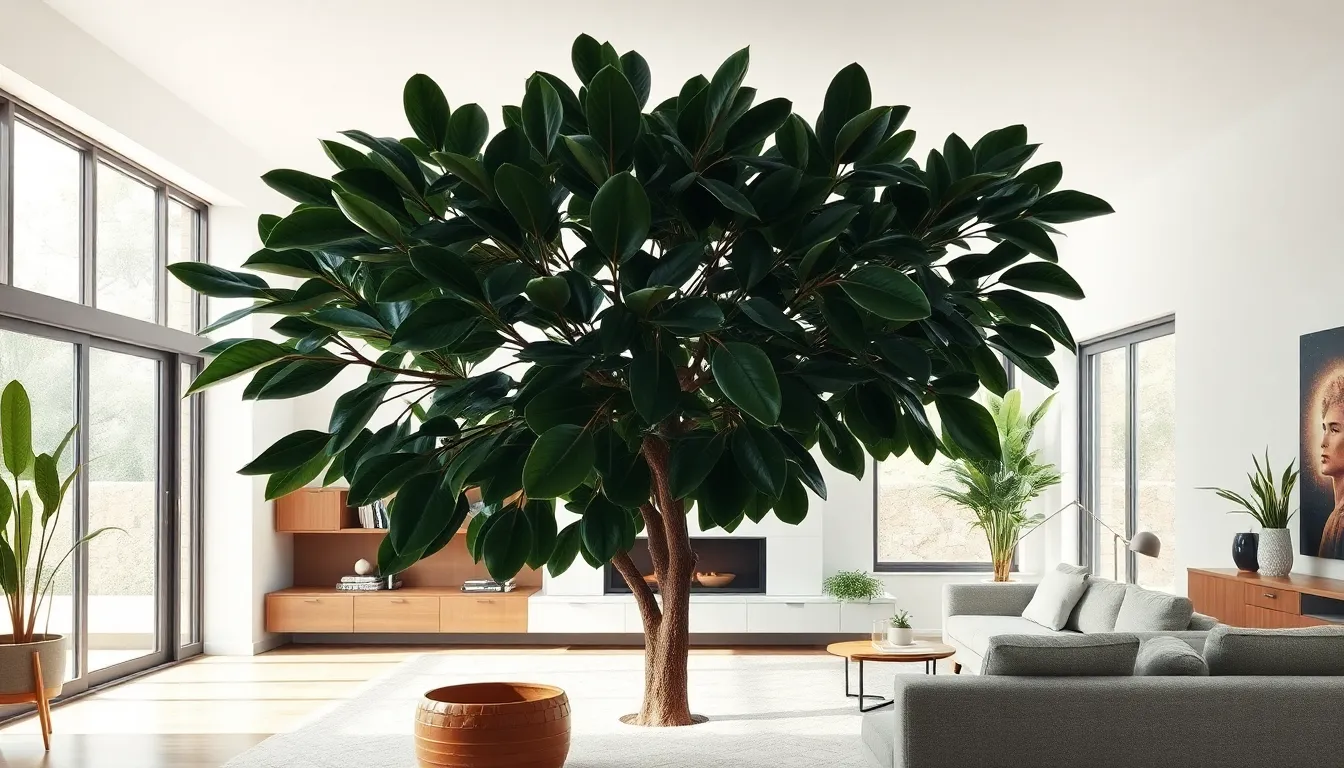
Following the architectural impact of snake plants, we turn to another mid century modern favorite that brings equally stunning visual drama to retro spaces. Rubber trees stand as sculptural masterpieces that perfectly complement the era’s emphasis on natural elements and functional beauty.
Glossy Dark Green Leaves
Large, glossy dark green leaves make rubber trees exceptional statement pieces in mid century modern interiors. These striking leaves create dramatic visual contrast against the clean, minimalist lines that define retro design aesthetics. Each leaf displays a rich, lustrous finish that reflects light beautifully throughout open plan spaces.
Bold foliage adds sculptural form that enhances the organic shapes fundamental to mid century modern principles. We find their substantial presence transforms rooms into gallery like spaces where nature becomes architectural art. Their distinctive appearance suits the movement’s celebration of natural materials and biophilic design elements.
Easy Propagation Methods
Stem cuttings provide the most reliable way to propagate rubber trees for expanding your mid century plant collection. We recommend taking 4 to 6 inch cuttings from healthy branches during spring growing season. These cuttings root easily in water within 2 to 4 weeks before transplanting to soil.
Accessible propagation makes rubber trees perfect for enthusiasts wanting to maintain consistent retro aesthetics throughout their homes. Growing multiple plants from one parent creates cohesive design flow across different rooms. This method aligns with the era’s DIY spirit and resourceful approach to home decoration.
Ideal Lighting Conditions
Bright, indirect light creates optimal growing conditions for rubber trees in typical mid century modern homes. These adaptable plants thrive near large windows with filtered sunlight that characterizes the era’s architectural emphasis on natural illumination. We position them 3 to 5 feet from windows to prevent leaf burn while ensuring adequate brightness.
Indoor settings benefit from rubber trees’ tolerance for varying light levels throughout the day. Their flexibility suits open floor plans where lighting changes as the sun moves across expansive glass surfaces. This adaptability makes them ideal companions for the ever-changing living spaces that define mid century modern lifestyle.
Fiddle Leaf Figs: Dramatic Height and Texture
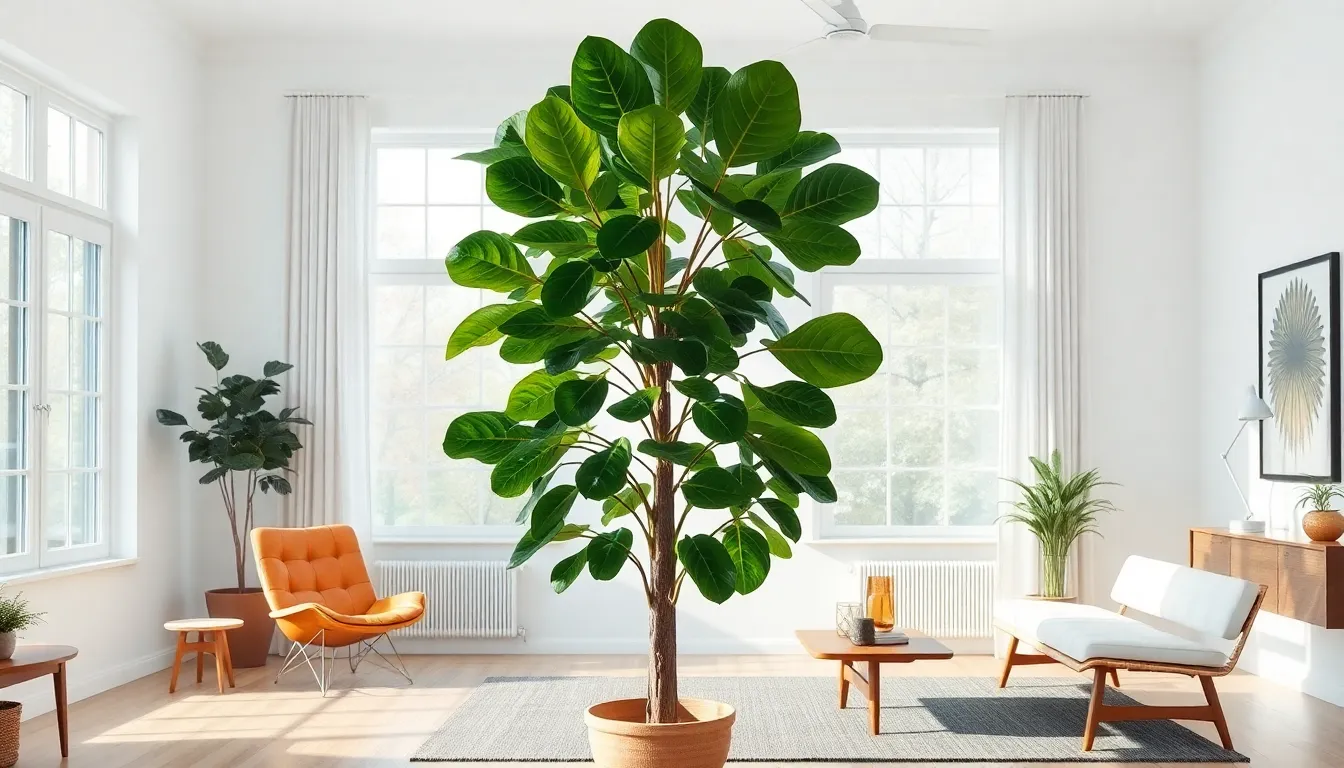
Fiddle Leaf Figs stand as the ultimate architectural plant for mid-century modern spaces, bringing both vertical drama and sophisticated texture that complements the era’s clean design principles. These stunning specimens create powerful focal points that transform any room into a gallery-worthy showcase.
Large Statement Leaves
Violin-shaped foliage makes Fiddle Leaf Figs (Ficus lyrata) the perfect complement to geometric mid-century furniture pieces. Their glossy, oversized leaves reach up to 18 inches long, creating dramatic contrasts against sleek surfaces and minimalist decor elements.
Bold visual impact comes naturally with these architectural specimens that tower up to 10 feet indoors. We love how their broad, patterned leaves bring tropical sophistication while maintaining the clean aesthetic that defines mid-century modern design.
Strategic placement near statement furniture pieces like Eames chairs or Nelson benches creates ever-changing visual triangles throughout your space. Position these dramatic plants in corners where their substantial presence can anchor entire room compositions without overwhelming the streamlined furniture arrangements.
Proper Watering Techniques
Consistent moisture management keeps Fiddle Leaf Figs thriving in mid-century modern environments where drainage and plant health matter most. We recommend checking the top inch of soil weekly, watering thoroughly only when it feels completely dry to your touch.
Deep watering sessions work better than frequent light sprinklings that can lead to shallow root development. Pour water slowly until it drains from the bottom holes, then empty saucers within 30 minutes to prevent root rot complications.
Seasonal adjustments become crucial during winter months when indoor heating reduces humidity levels significantly. Reduce watering frequency by 25-30% during cooler seasons while maintaining the same soil moisture checking routine that keeps your plants healthy year-round.
Common Care Mistakes to Avoid
| Mistake | Consequence | Prevention |
|---|---|---|
| Overwatering | Root rot and leaf dropping | Check soil moisture weekly |
| Insufficient light | Stunted growth and pale leaves | Place in bright, indirect light |
| Ignoring humidity | Brown leaf edges and dropping | Maintain 40-50% humidity levels |
| Poor drainage | Waterlogged soil and root issues | Use pots with drainage holes |
Light positioning errors cause the most dramatic plant failures we see in mid-century modern spaces. Place your Fiddle Leaf Fig within 3-6 feet of large windows where it receives bright, filtered sunlight without direct exposure that scorches those beautiful violin-shaped leaves.
Humidity neglect becomes especially problematic in homes with central heating systems that dry indoor air significantly. We suggest grouping plants together or using wooden plant stands with water trays to create localized humidity zones that support healthy growth patterns.
Repotting frequency mistakes often stem from moving plants too frequently or waiting too long between container changes. These architectural specimens prefer slightly snug roots and only need repotting every 2-3 years when growth patterns clearly indicate they’ve outgrown their current containers.
Monstera Deliciosa: Split-Leaf Tropical Charm
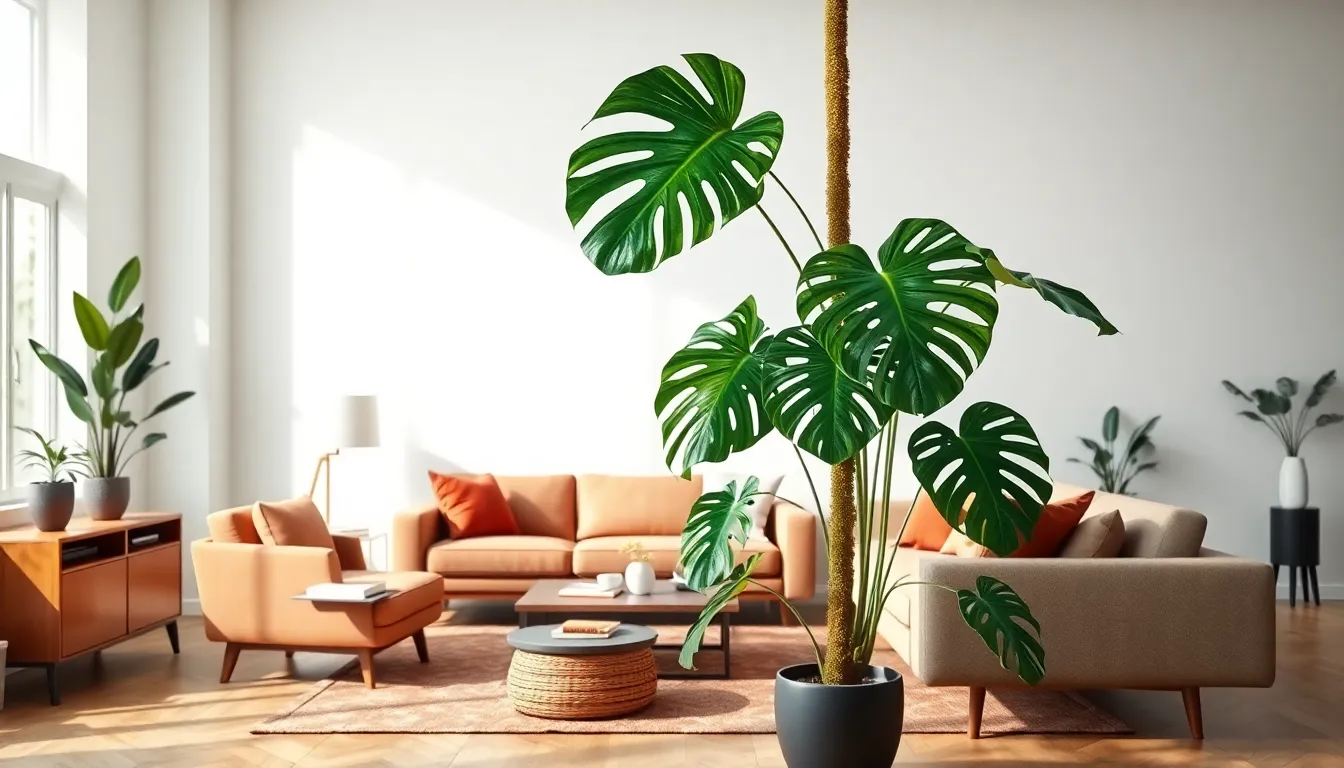
Monstera deliciosa stands out as another quintessential plant that perfectly captures the essence of mid-century modern design. This tropical beauty brings organic elegance to clean, angular spaces with its distinctive foliage.
Iconic Perforated Foliage
Monstera deliciosa earns its reputation through large, glossy green leaves featuring deep splits and natural holes. These dramatic perforations create what many call “Swiss cheese” leaves that add incredible texture and visual interest to any mid-century modern space. Large mature leaves can span up to 3 feet across, making bold architectural statements that complement geometric furniture pieces. The natural fenestrations develop as the plant matures, starting with solid juvenile leaves that gradually split and develop holes over time. This evolution creates ever-changing visual appeal that changes throughout the plant’s life cycle.
Climbing and Support Systems
Monsteras naturally climb trees in their tropical habitat using specialized aerial roots that seek vertical support. Indoor cultivation requires providing sturdy support systems such as moss poles or wooden stakes to maintain the plant’s dramatic upright form. These climbing structures allow the plant to reach impressive heights of 6-8 feet indoors while showcasing its architectural presence. Aerial roots will actively attach to textured surfaces, creating living sculptures that enhance vertical design elements common in mid-century modern interiors. Training the plant upward prevents it from becoming sprawling and maintains the clean lines that define this design aesthetic.
Humidity Requirements
Optimal growth occurs when humidity levels remain between 40-60%, mimicking the plant’s natural tropical environment. We can achieve these conditions using humidifiers or positioning plants in naturally humid areas like bathrooms with adequate light. Normal indoor humidity levels are tolerable, but higher moisture promotes healthier leaf development and more dramatic fenestration patterns. Grouping tropical plants together creates beneficial microclimates that boost ambient humidity naturally. Regular misting can supplement humidity levels, though direct water on leaves should be avoided to prevent fungal issues.
Peace Lilies: Elegant White Blooms and Clean Lines
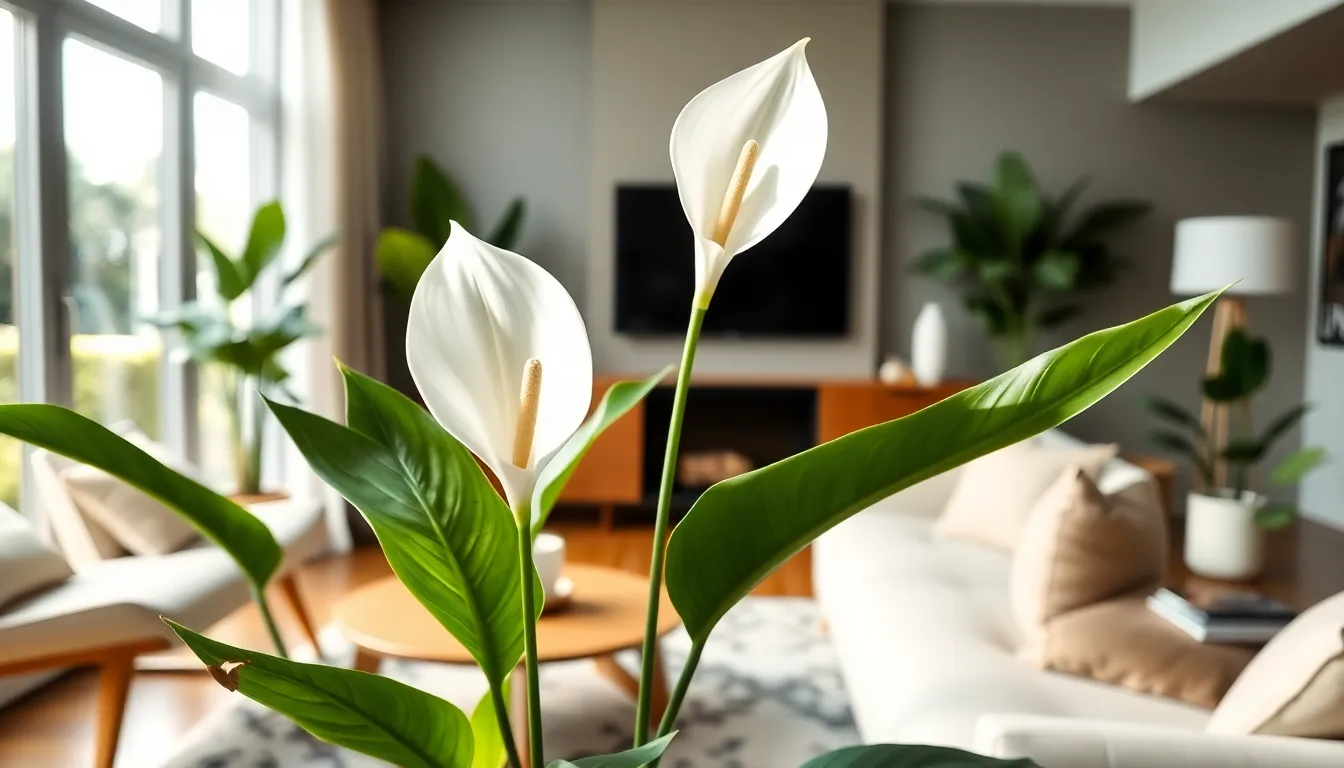
Peace lilies bring refined sophistication to mid century modern interiors with their sculptural white blooms and glossy green foliage. We love how these plants seamlessly blend functionality with the era’s minimalist aesthetic principles.
Sophisticated Flower Display
White blooms emerge as elegant focal points that never overwhelm the space’s clean design lines. Peace lilies produce sophisticated spoon shaped flowers called spathes that rise gracefully above their foliage canopy. Each bloom maintains the understated elegance that defines mid century modern style perfectly.
We appreciate how their smooth glossy leaves create visual contrast against geometric furniture pieces and angular room layouts. Their flowers add refined beauty without introducing excessive color that might clash with neutral palettes. The plant’s natural symmetry echoes the balanced proportions found in iconic mid century architecture.
Low Light Tolerance
Thriving in low light conditions makes peace lilies perfect for mid century modern rooms with simple natural lighting schemes. We find they adapt beautifully to spaces that receive indirect sunlight through large picture windows or clerestory openings. Their tolerance for dimmer environments allows placement near statement furniture pieces without requiring bright overhead illumination.
Interior spaces with north facing windows provide ideal growing conditions for these adaptable plants. They maintain their lush appearance even in areas where other houseplants might struggle to survive. We recommend positioning peace lilies away from direct sun exposure to prevent leaf scorching while ensuring adequate ambient light.
Natural Air Filtration
Filtering formaldehyde, benzene, and other common indoor toxins makes peace lilies valuable additions to healthy mid century modern homes. We value their ability to purify indoor air while contributing to the era’s emphasis on wellness and comfort in residential design. Their natural filtration system works continuously to remove harmful chemicals from interior environments.
NASA studies confirm peace lilies effectively clean indoor air by absorbing pollutants through their leaves and root systems. They process volatile organic compounds commonly found in modern building materials and household products. We appreciate how these plants support both aesthetic goals and environmental health within our living spaces.
Philodendrons: Versatile Trailing and Climbing Options
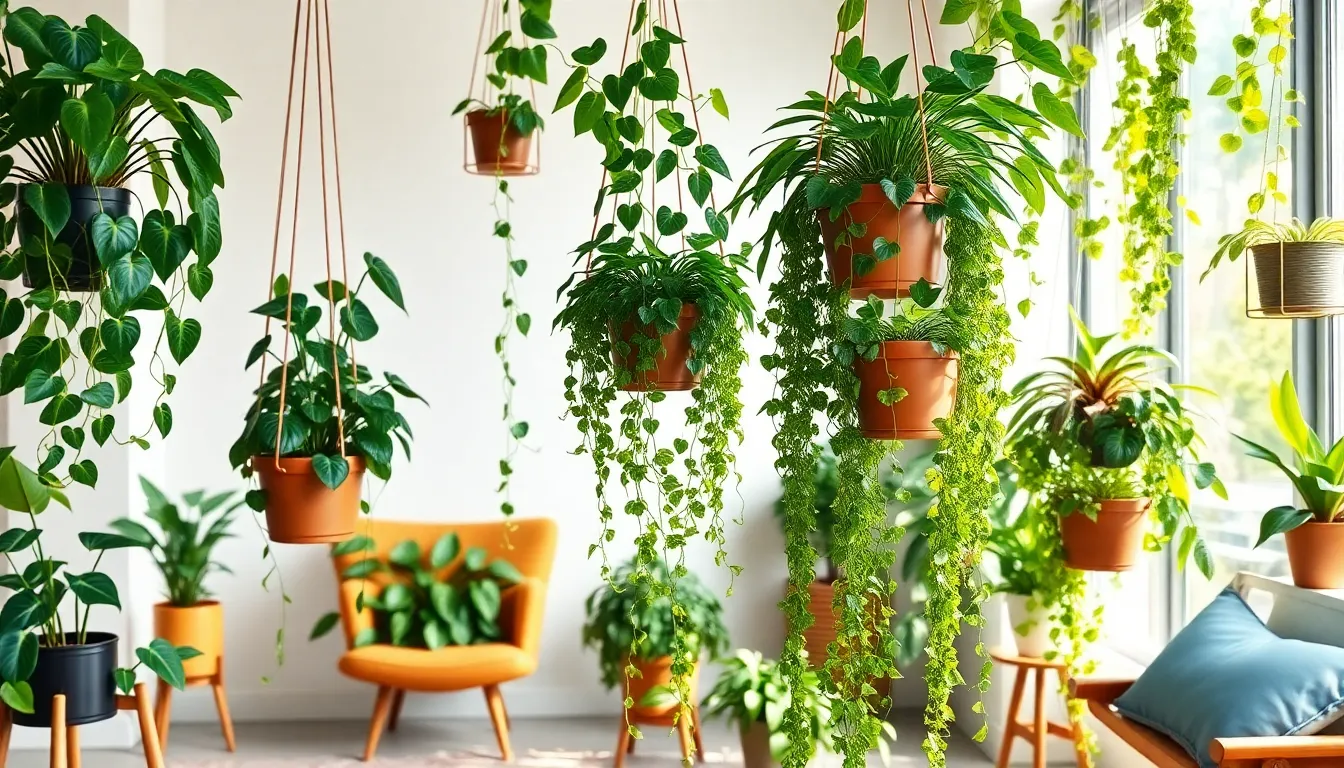
Philodendrons offer incredible flexibility for mid century modern spaces with their diverse growth patterns and adaptable nature. These tropical beauties from the rainforests of the Americas excel in indoor environments thanks to their tolerance for lower light conditions typical of shaded understories.
Heart-Shaped Leaf Varieties
Heart-shaped leaves make philodendrons instantly recognizable and perfectly suited for mid century modern aesthetics. Philodendron gloriosum stands out with its velvety, large heart-shaped leaves adorned with striking white veins that add remarkable texture and visual interest to any space. Different varieties showcase leaves ranging from glossy to velvety surfaces, creating diverse textural elements that complement the clean lines and natural materials characteristic of mid century modern design. These distinctive leaf shapes provide the organic forms that mid century modern interiors celebrate while maintaining the architectural qualities that define the style.
Hanging Basket Presentations
Trailing philodendrons thrive magnificently in hanging baskets where their vines cascade freely to create lush, dramatic effects. Climbing varieties like Philodendron scandens use aerial roots to anchor themselves, making them ideal for vertical displays that enhance the architectural elements of mid century modern rooms. Their cascading growth pattern fills open, airy interiors with natural elements that emphasize the indoor-outdoor living philosophy central to mid century design. Hanging presentations allow these plants to create ever-changing visual layers that complement the geometric furniture pieces while adding organic movement to structured spaces.
Quick Growth Characteristics
Fast growth rates make philodendrons particularly appealing for homeowners who want immediate impact in their mid century modern interiors. These plants respond quickly to moderate to bright indirect light and consistent moisture, delivering rapid results that satisfy plant enthusiasts seeking instant gratification. Their speedy development supports the ever-changing, lived-in aesthetic that mid century modern homes embrace, creating evolving focal points that change and grow with the space. Quick establishment means you’ll see substantial growth within months, allowing these plants to fill vertical or horizontal spaces efficiently while maintaining the balanced proportions essential to mid century modern design principles.
Bird of Paradise: Exotic Architectural Appeal
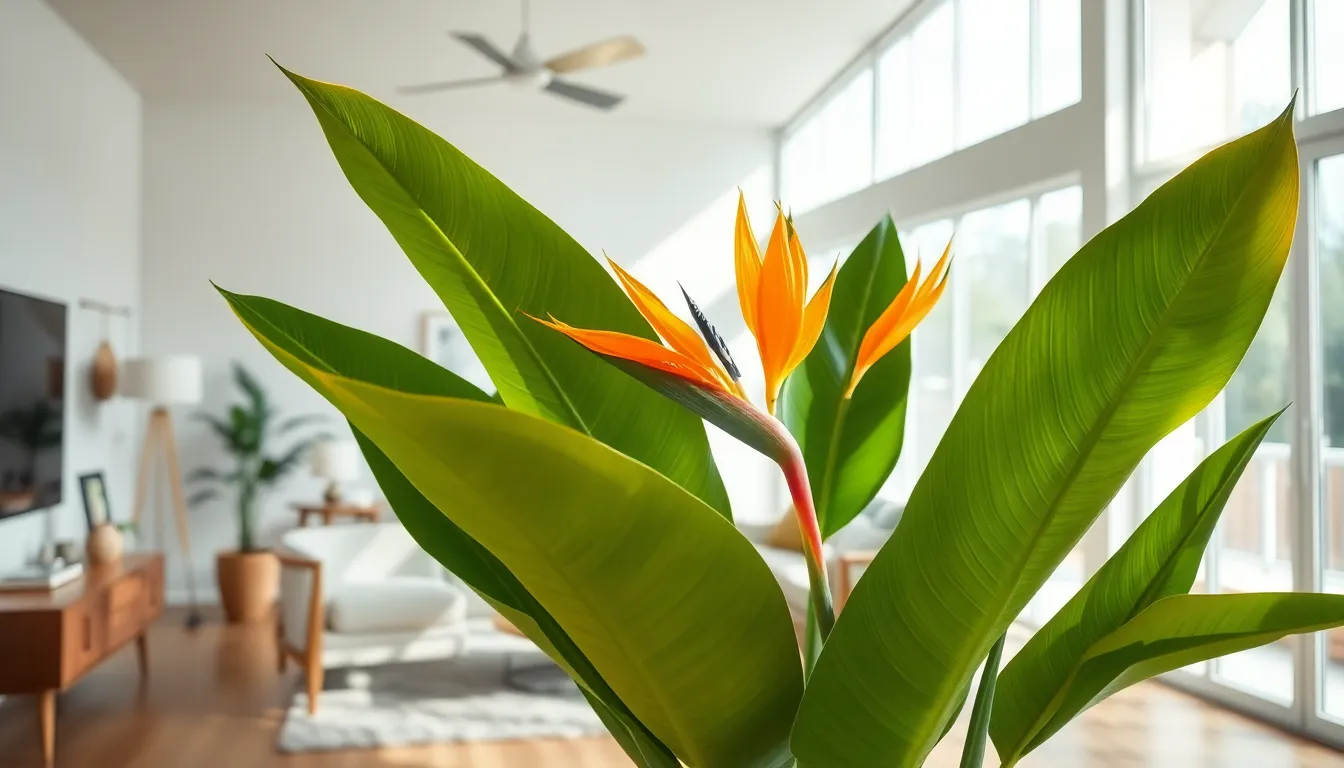
Following our exploration of versatile philodendrons, we’re excited to introduce the Bird of Paradise (Strelitzia reginae), a plant that perfectly embodies mid century modern design principles through its exotic yet architectural presence.
Paddle-Shaped Leaves
Large, glossy leaves make the Bird of Paradise visually impactful in any mid century modern space. These broad, paddle shaped foliage pieces resemble banana plant leaves, creating dramatic tropical vibes that complement the era’s emphasis on natural forms. We love how these substantial leaves provide volume and texture without overwhelming clean, functional design lines.
Balancing clean aesthetics becomes effortless with Bird of Paradise leaves that harmonize beautifully with open layouts and minimal décor. Their glossy surface reflects light throughout the room, improving the bright, airy atmosphere that defines mid century modern interiors. Each leaf creates striking geometric shadows that dance across walls, adding ever-changing visual interest to your space.
Space Requirements and Sizing
Substantial floor space is essential for Bird of Paradise plants, which often reach several feet in height at maturity. We recommend positioning these plants in large corners or expansive areas where they won’t crowd your carefully curated furniture arrangements. Their impressive growth habit suits mid century modern homes perfectly, taking advantage of the style’s characteristic spacious interiors.
Strategic placement considerations should account for the plant’s full mature size to maintain proper proportions within your room. Bird of Paradise plants thrive as both indoor and outdoor accents in homes with large windows and open floor plans. We suggest allowing at least 4 to 6 feet of clearance around the plant to showcase its architectural form effectively.
Bright Light Preferences
Natural light requirements make Bird of Paradise plants ideal companions for mid century modern homes featuring floor to ceiling glass windows. These plants prefer bright, indirect light that abundant natural light provides, promoting healthy growth and encouraging the development of their iconic orange and blue flowers. We find they perform best when positioned near large windows typical of the era’s design.
Optimal lighting conditions directly impact the plant’s ability to maintain its striking aesthetic appeal and architectural structure. Adequate bright light prevents legginess and keeps the paddle shaped leaves vibrant and substantial. We recommend rotating your Bird of Paradise occasionally to ensure even light distribution and maintain its sculptural form as a focal point in your mid century modern interior.
ZZ Plants: Sleek Minimalist Greenery
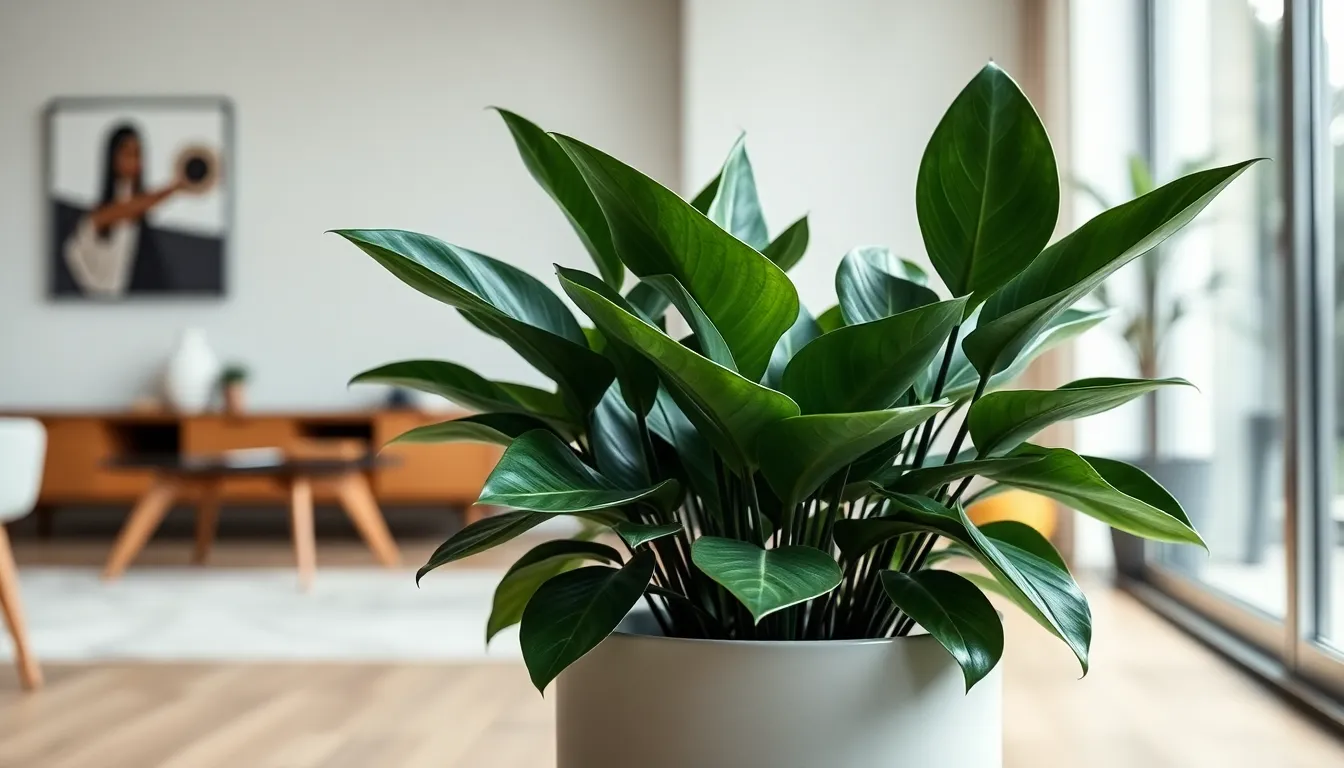
ZZ plants represent the perfect marriage of function and form in mid-century modern interior design. Their architectural presence adds sophisticated greenery without compromising the clean aesthetic we love.
Waxy Geometric Foliage
ZZ plants showcase their signature waxy, geometric foliage that embodies minimalist greenery principles. The glossy, smooth texture of their leaves creates a contemporary feel that complements mid-century modern aesthetics perfectly. Each leaf displays a structured pattern that echoes the clean lines found in iconic furniture pieces from the era.
Their upright growth habit forms natural geometric shapes that serve as living sculptures in our spaces. The leaves catch and reflect light beautifully, creating ever-changing visual interest throughout the day. We appreciate how their sleek appearance adds depth without introducing excessive ornamentation to our carefully curated interiors.
Drought Tolerant Features
ZZ plants thrive with minimal watering requirements, making them ideal for the functional simplicity emphasized in mid-century design. Their drought tolerant nature means we can maintain stunning greenery without constant attention or complex care routines. These plants store water efficiently in their thick stems and roots, allowing them to survive extended periods between waterings.
Low maintenance characteristics align perfectly with the practical lifestyle ethos of mid-century modern living. We can travel for weeks without worrying about plant care, yet return to find our ZZ plants looking as vibrant as ever. Their resilience makes them perfect for busy homeowners who want beautiful greenery without the commitment of high maintenance plants.
Perfect for Modern Planters
ZZ plants complement modern planters and clean architectural interiors seamlessly due to their structured growth pattern. Their vertical lines work beautifully in cylindrical ceramic vessels, rectangular concrete planters, and sleek fiberglass containers typical of mid-century design. The plants’ proportions create perfect balance whether we choose tall floor planters or compact tabletop versions.
Their adaptability to various planter styles means we can experiment with different materials like teak, brass, or white ceramic to match our existing decor. The contrast between their dark green foliage and modern planter finishes creates striking focal points that enhance rather than overwhelm our minimalist spaces.
Styling Tips for Mid Century Modern Plant Displays
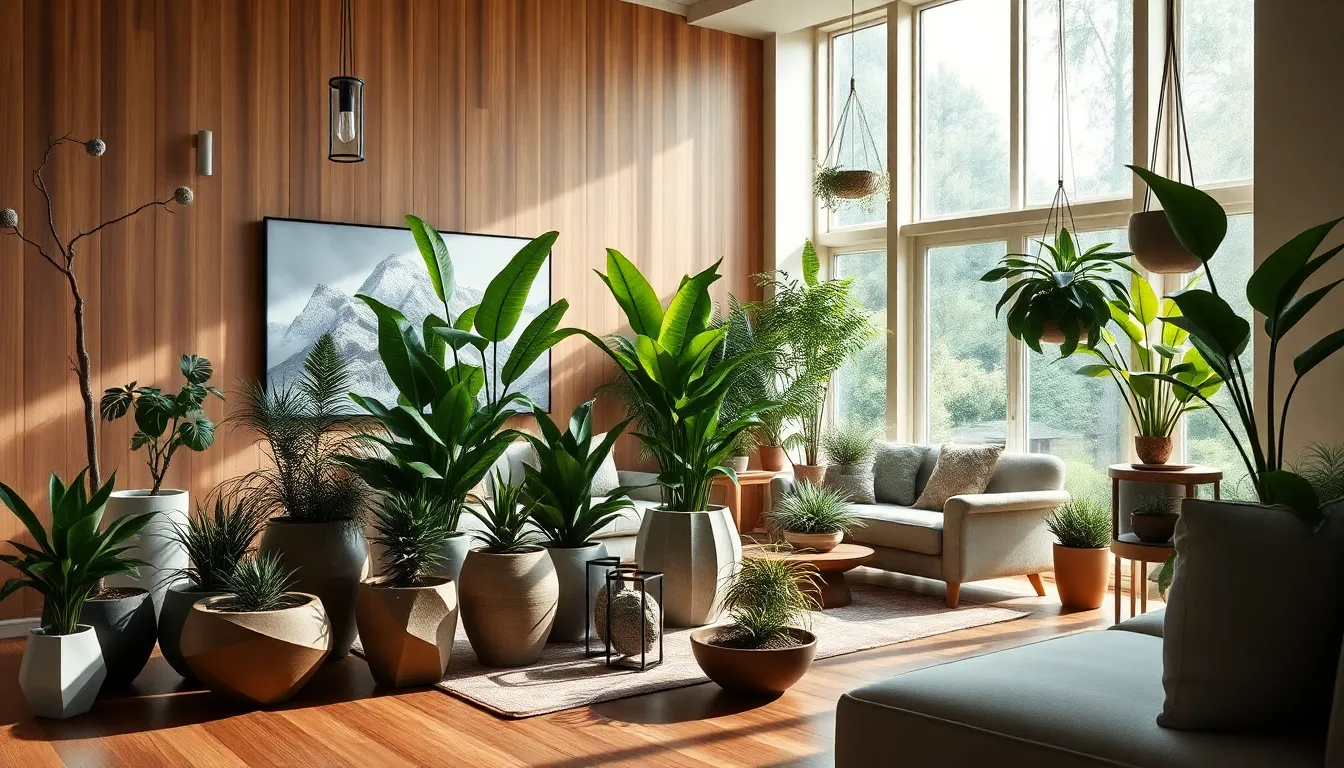
Now that we’ve explored the perfect plants for your mid century modern space, let’s jump into the styling techniques that’ll transform your greenery into stunning design elements.
Choosing Period-Appropriate Planters
Selecting the right planters is crucial for achieving that authentic mid century modern aesthetic. Geometric shapes define this era’s design philosophy, so we recommend cylindrical planters with clean, unadorned surfaces that complement your furniture’s sleek lines. Ceramic planters with smooth finishes create visual harmony with the period’s emphasis on craftsmanship and quality materials.
Materials matter when choosing authentic pieces for your space. Stone planters with concrete-like textures add organic warmth while maintaining the structured feel that defines this design movement. Organic curves balance geometric elements, creating visual interest without disrupting the clean aesthetic we’re working to achieve.
Color choices should reflect the era’s sophisticated palette preferences. Earthy tones like warm browns, deep oranges, and muted yellows complement the natural wood tones common in mid century modern furniture. Bold accent colors work beautifully as statement pieces, particularly in vibrant blues or rich burgundies that echo the period’s optimistic spirit.
Finish selection impacts the overall visual weight of your plant displays. Matte finishes create subtle sophistication, while softly glazed surfaces add gentle luminosity without overwhelming the space’s balanced proportions.
Creating Balanced Compositions
Visual weight distribution forms the foundation of successful mid century modern plant arrangements. Large statement planters measuring 10-14 inches work perfectly near major furniture pieces like couches, creating focal points that anchor your room’s design without competing for attention.
Medium-sized planters between 6-8 inches complement side tables and chairs beautifully, adding greenery at comfortable eye level. These pieces bridge the gap between dramatic floor plants and delicate accent pieces, maintaining the harmonious flow essential to this design aesthetic.
Small plants in 4-inch containers excel on shelves and coffee tables, providing textural interest without cluttering surfaces. Grouping these smaller plants together creates impact while preserving the clean, uncluttered feel that characterizes mid century modern interiors.
Strategic placement near architectural features draws the eye naturally through your space. We recommend positioning plant groupings beside built-in shelving, near large windows, or adjacent to signature furniture pieces to create visual connections that enhance rather than compete with existing design elements.
Incorporating Plant Stands and Pedestals
Minimalist stands add essential vertical dimension while maintaining the period’s emphasis on functional simplicity. These elevated platforms create airy feelings that complement the clean, lifted lines found throughout mid century modern furniture design.
Height variation prevents monotonous arrangements and adds visual rhythm to your plant displays. Mixing floor plants with elevated specimens creates layered compositions that feel intentional and sophisticated rather than randomly placed.
Wall-mounted planters maximize space efficiency while honoring the era’s innovative approach to interior design. These suspended gardens work particularly well with trailing plants, creating living artwork that transforms blank walls into ever-changing focal points.
Hanging baskets with trailing varieties like philodendrons enhance verticality while maintaining the balanced proportions essential to this design movement. Position these elevated gardens near windows or in corners to create depth without blocking natural light flow or disrupting traffic patterns through your space.
Conclusion
We’ve explored how the right plants can transform your mid-century modern space into a living work of art. From the architectural drama of Snake Plants to the tropical elegance of Bird of Paradise each species we’ve discussed brings its own unique character while honoring the era’s commitment to bringing nature indoors.
The key lies in selecting plants that complement rather than compete with your space’s clean lines and geometric forms. Whether you choose the sculptural presence of a Fiddle Leaf Fig or the versatile charm of trailing Philodendrons you’re creating that perfect balance between natural beauty and modernist design principles.
Remember that successful mid-century modern plant styling isn’t just about the plants themselves—it’s about thoughtful placement period-appropriate planters and creating visual harmony throughout your space. With these carefully chosen green companions your home will embody the timeless sophistication that makes mid-century modern design so enduringly popular.
Frequently Asked Questions
What makes snake plants perfect for mid-century modern interiors?
Snake plants are ideal for mid-century modern design because of their bold, sculptural presence and dramatic vertical lines that complement clean furniture aesthetics. They require minimal maintenance, thrive in low light conditions, and provide excellent air-purifying benefits while creating striking geometric forms that enhance the era’s emphasis on bringing nature indoors.
How do rubber trees enhance mid-century modern spaces?
Rubber trees add visual drama with their large, glossy dark green leaves that serve as sculptural masterpieces. Their substantial presence transforms rooms into gallery-like spaces, creating dramatic contrasts against minimalist lines while celebrating natural materials and biophilic design elements essential to mid-century modern aesthetics.
Why are Fiddle Leaf Figs considered architectural plants for this design style?
Fiddle Leaf Figs are known for their vertical drama and sophisticated texture, with large violin-shaped leaves that create powerful focal points. They can reach up to 10 feet indoors, providing the height and architectural presence that complements geometric furniture pieces while maintaining the balanced proportions essential to mid-century modern design.
What makes Monstera deliciosa quintessential for mid-century modern design?
Monstera deliciosa embodies mid-century modern principles with its iconic perforated foliage featuring deep splits and holes. The large, glossy leaves add texture and visual interest, while its climbing nature enhances vertical design elements. The plant’s dramatic form perfectly captures the era’s celebration of natural architectural elements.
How do Peace Lilies complement mid-century modern aesthetics?
Peace Lilies bring refined sophistication with their sculptural white blooms and glossy green foliage. Their elegant, spoon-shaped flowers serve as focal points that complement minimalist aesthetics without overwhelming spaces. They thrive in low light conditions and effectively filter indoor air pollutants, aligning with the era’s wellness emphasis.
What styling tips work best for mid-century modern plant displays?
Choose period-appropriate planters with geometric shapes and earthy color palettes, such as cylindrical ceramic or stone vessels. Create balanced compositions with plants of varying sizes, incorporate minimalist plant stands for verticality, and use wall-mounted planters to maximize space efficiency while maintaining the clean, uncluttered aesthetic.
Which plants require the least maintenance for mid-century modern homes?
ZZ plants and snake plants are the most low-maintenance options. ZZ plants are drought-tolerant with waxy, geometric foliage that requires minimal care, while snake plants thrive with minimal attention and adapt well to various light conditions, making both perfect for busy homeowners seeking stylish, functional greenery.

